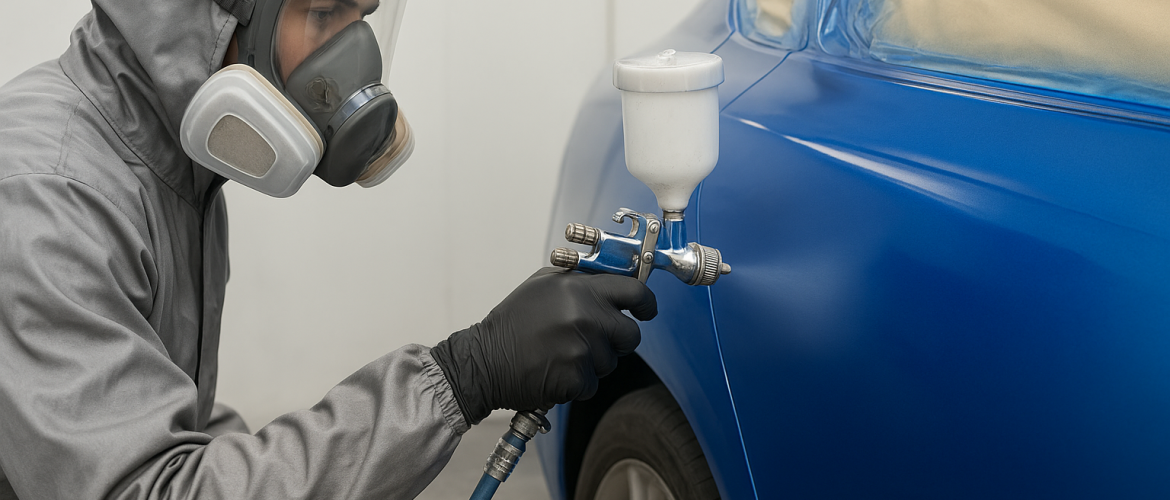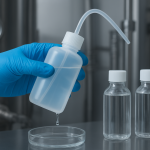What Is Auto Base Coat Paint?
Auto base coat paint is the layer of color applied after priming and before the final protective clear coat. It contains pigment and resin but lacks the protective properties of clear coat. Its primary job is to establish the vehicle’s actual color and create the needed surface for the clear coat to bond with.
Because base coat sits beneath the clear coat, it must be smooth, even, and properly applied. Any inconsistencies in the base layer will show through in the final finish.
Why Auto Base Coat Paint Matters
It Provides Rich, Even Color Coverage
Base coat is responsible for the full color saturation of the paint job. Unlike older single stage paint systems, modern base coat systems separate color from protection. This makes it possible to achieve:
- Deep, vibrant tones
- Metallic or pearlescent effects
- Smooth color transitions
- More precise color matching
The formula of base coat allows for a more controlled and uniform application. Painters can apply multiple light coats to build up perfect coverage without heavy buildup or texture issues.
It Creates a Smooth Foundation for Clear Coat
Clear coat cannot bond properly to a rough or uneven surface. Auto base coat paint provides the essential bonding layer required for a durable protective finish.
A properly applied base coat ensures:
- Better adherence of the clear coat
- Reduced risk of peeling or flaking
- A smoother final surface
- A more professional, glossy appearance
If the base coat is applied incorrectly, the clear coat will highlight imperfections instead of concealing them.
It Enhances Depth and Dimension
Many automotive finishes today use metallic, pearl, or candy color base coats. These specialized paints cannot achieve their effect without the layering structure of a base and clear system.
- Light reflection through metallic flakes
- Multi dimensional shine
- Layered color effects
- High definition visuals under clear coat
This is why custom paint jobs rely heavily on precise base coat layering to achieve unique colors and effects.
It Contributes to Long Term Durability
While clear coat provides UV and chemical protection, the base coat contributes to the overall longevity of the paint.
A high quality base coat ensures that:
- The color does not fade prematurely
- The surface maintains adhesion through temperature changes
- The clear coat remains stable and intact
- The overall paint system lasts longer
This is where the importance of high quality materials becomes clear. Inferior base coat formulas break down more quickly, leading to fading, delamination, or uneven texture over time.
Common Types of Auto Base Coat Paint
Solid Color Base Coats
These provide uniform color without flakes or special effects. Great for fleet vehicles or classic restorations.
Metallic Base Coats
Contain fine metal flakes for a reflective sheen. Popular in modern production vehicles.
Pearlescent Base Coats
Use mica flakes to create iridescent color shifts and multi angle shine.
Candy Base Coats
Typically transparent colors applied over a reflective base. These create deep, vibrant finishes perfect for custom and show cars.
Proper Application Techniques for Best Results
High quality base coat is essential, but technique matters just as much. As the anchor text emphasizes, Using auto base coat paint can significantly enhance the final appearance and durability of your vehicle’s paint job. It’s crucial to choose high-quality materials and follow proper application techniques for the best results.
Below are key steps professionals follow to maximize results.
Surface Preparation
Proper sanding, priming, and cleaning ensure that the base coat adheres properly.
Correct Spray Distance and Pressure
Spraying too close creates runs. Spraying too far leads to uneven coverage or dry spray.
Thin, Even Layers
Base coat should be applied in multiple light coats, not heavy wet coats.
Flash Time Between Coats
Allowing each layer to dry properly prevents solvent trapping and texture issues.
Final Inspection Before Clear Coat
Any flaws in the base coat must be corrected before the clear coat is added.
The Role of Clear Coat
While this article focuses on base coat, the complete finish depends on the interaction between the base coat and clear coat. Clear coat:
- Locks in the color
- Provides UV and chemical resistance
- Creates a glossy finish
- Allows for polishing and protection
However, even the best clear coat cannot compensate for poor base coat application. The two work together to create a professional result.
Why DIY Painters Should Not Skip Base Coat Quality
Many DIY automotive painters attempt to save money by using lower grade base coat products. This often leads to:
- Poor color accuracy
- Visible imperfections
- Low depth or dull appearance
- Clear coat adhesion problems
- Reduced durability
Investing in a high quality base coat saves time, enhances appearance, and ensures the paint job lasts far longer.
Final Thoughts
Auto base coat paint is far more important than just adding color to a vehicle. It serves as the critical foundation that determines how the final finish will look and how long it will last. A professional level paint job relies on high quality materials, correct preparation, and proper application techniques. Remember that Using auto base coat paint can significantly enhance the final appearance and durability of your vehicle’s paint job. It’s crucial to choose high-quality materials and follow proper application techniques for the best results.
For anyone looking to achieve a flawless finish, investing in the right base coat and taking the time to apply it correctly is essential.
FAQs
What is the purpose of auto base coat paint?
It provides color, creates a smooth surface for the clear coat, and contributes to depth and visual appeal.
Can you apply clear coat without base coat?
Clear coat requires a pigmented base coat for proper adhesion and visual results.
How many coats of base coat should be applied?
Typically two to four light coats depending on color depth, coverage, and transparency.
Does base coat provide protection?
Base coat provides color and adhesion. Protection comes primarily from the clear coat.
Why does base coat appear dull before clear coat?
Base coat is designed to look matte until the clear coat is applied. This is normal.



